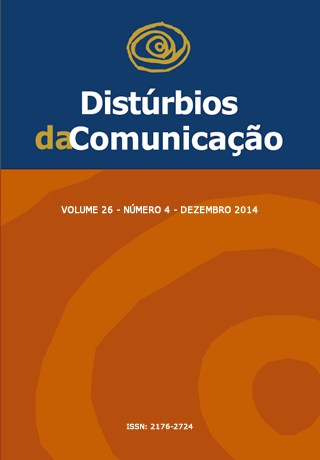Lexical performance of children with specific language impairment in formal assessment and spontaneous speech
Keywords:
Child, Language, Vocabulary, Language Development, Language Development DisordersAbstract
Introduction: lexical impairment uses to be one of the first difficulties observed in children withlanguage impairment and the expressive vocabulary is pointed as an important measure of languagedevelopment. Aim: to verify which is the relation between the percentage of usual word designation(UWD) in formal assessment and the noun use in spontaneous speech of children with specific languageimpairment (SLI). Methods: 30 subjects of both genders and with ages between 4 and 5 years old had theyreports consulted. They all had an SLI diagnostic and were in language therapy for at least a year. Thepercentage of usual word designation was collected from the formal assessment of expressive vocabulary,and the noun use in spontaneous speech was based on the total use and the diversity of nouns used by thechild during the pragmatics assessment. Results: a continuous increase occurred in UWD during formalassessment, but the same pattern was not observed in spontaneous speech. In addition, there was nocorrelation between UWD and total use or diversity of nouns used in spontaneous speech. Conclusion:the relationship between lexical performance in formal assessment and spontaneous speech is not direct,which means that the improvement of items recognition in isolate tasks not necessarily implies in a betteruse in real communication. Therefore, it is important that language evaluation of children with languageimpairment be also based on a carefully analysis of spontaneous speech.Downloads
Metrics
Downloads
Published
Issue
Section
License
Copyright (c) 2015 Fabianna Andrade Barella, Ana Manhani Cáceres-Assenço, Amalia Rodrigues, Debora Maria Befi-Lopes

This work is licensed under a Creative Commons Attribution 4.0 International License.









